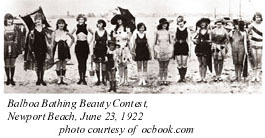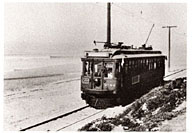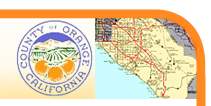 When Captain Samuel S. Dunnells successfully steered
his 105-ton river steamer Vaquero through upper
Newport Bay in 1870, James and Robert McFadden rushed
from Northern California by stagecoach to mark the
inaugural voyage.
When Captain Samuel S. Dunnells successfully steered
his 105-ton river steamer Vaquero through upper
Newport Bay in 1870, James and Robert McFadden rushed
from Northern California by stagecoach to mark the
inaugural voyage.
Dunnells'
trip cast new light on the bay, which many had
said was too treacherous for travel. But the principal
landowners in the area - the McFadden brothers
and James Irvine - thought they had something
after Dunnells' trip. A "new port,"
they mused, and the name stuck, according to the
Newport Beach Historical Society.
More
than 100 years later, Newport Beach's harbor is
crowded with pleasure, fishing and tour boats,
and its streets are busy with shoppers browsing
at Fashion Island mall, tourists enjoying Balboa
bars on Balboa Island and surfers tackling The
Wedge or other hot spots along the city's 6.2
miles of beaches.
Newport
wasn't always such a desirable place. In the mid-1800s,
the state of California sold parts of Harbor,
Balboa and Lido islands for $1 an acre as "swamp
and overflow land," according to the Newport
Beach Historical Society.
The
McFaddens saw something else. In 1888, they decided
their shipping business would be more successful
if they moved it from the inner shores of the
bay to the oceanfront, where they could build
a wharf. McFadden Wharf soon became the largest
business in newly created Orange County, according
the the historical society.
In
August 1906, residents in the booming bay town
voted to incorporate. The vote was 42-12 to become
the city of Newport Beach. Back then, bay front
houses sold for as little as $500. Today, the
median price of homes in Newport Beach is approximately
$545,000.
Residents
identify closely with their "villages"
- including Corona del Mar, west Newport and the
Harbor, Lido and Balboa islands - rather than
Newport Beach itself. Homes are separated
from busy commercial areas such as Lido Village,
Mariner's Mile and Newport
Center.
One
hundred years after the McFaddens built what
is now Newport Pier, the city still revels in
its ocean roots. Back them, only a few dozen summer
cottages could be rented, and a few dozen people
called Newport home.
Historical
Sites:
 Balboa
Pavilion - 400 Main St. Balboa
Pavilion - 400 Main St.
Newport Beach's first landmark was built in 1905.
The Scandinavian-style pavilion was the end of
the line for the Pacific Electric Red Car. The
"balboa Hop" dance began there during
World War II. The pavilion now contains a variety
of shops, a restaurant and a chartering company.
McFadden's
Wharf - Newport Pier
Completed in 1889, the wharf was the beginning
of Newport's decade as a shipping port. The wharf
was built by James and Robert McFadden, who shipped
lumber from Northern California to settlers here.
Old
Landing - Highway 101 & Dover Dr.
In 1870 the first steamer entered Newport Bay
and unloaded cargo near what is known as Old Landing.
The landing was designated a new port, or "Newport",
by the McFaddens, who established a regular shipping
service in the area. There is a bridge and a highway
on part of the site now. The rest of the area
is vacant.
Rendezvous
Ballroom - Ocean Front (Between Washington
& Palm Streets)
The
ballroom originally was a small dance hall that
competed with the Balboa Pavilion. In 1928 a new
Rendezvous Ballroom was built and began to feature
such big bands as Benny Goiodman's group. The
ballroom burned down in 1935, was rebuilt, and
burned down again in 1966. The site now contains
condominiums.
SITE
OF FIRST WATER-TO-WATER FLIGHT - Location:
S end of Main St at Ocean Front (Balboa), Newport
Beach.
On May 10, 1912, Glenn L. Martin flew his own
plane, built in Santa Ana, from the waters of
the Pacific Ocean at Balboa to Catalina Island.
This was the first water-to-water flight, and
the longest and fastest overwater flight, to that
date. On his return to the mainland, Martin carried
the day's mail from Catalina-another first.
|



![]()



